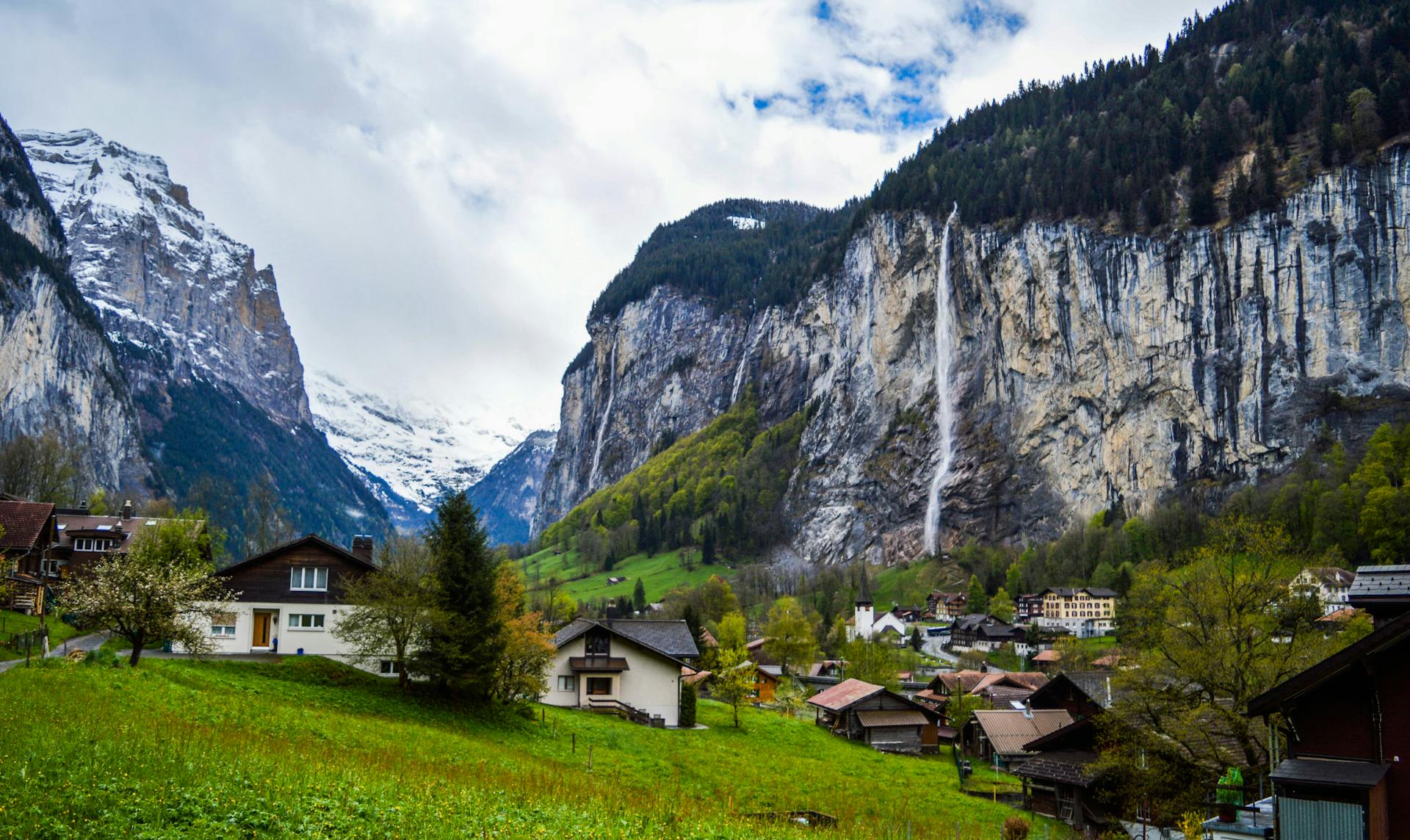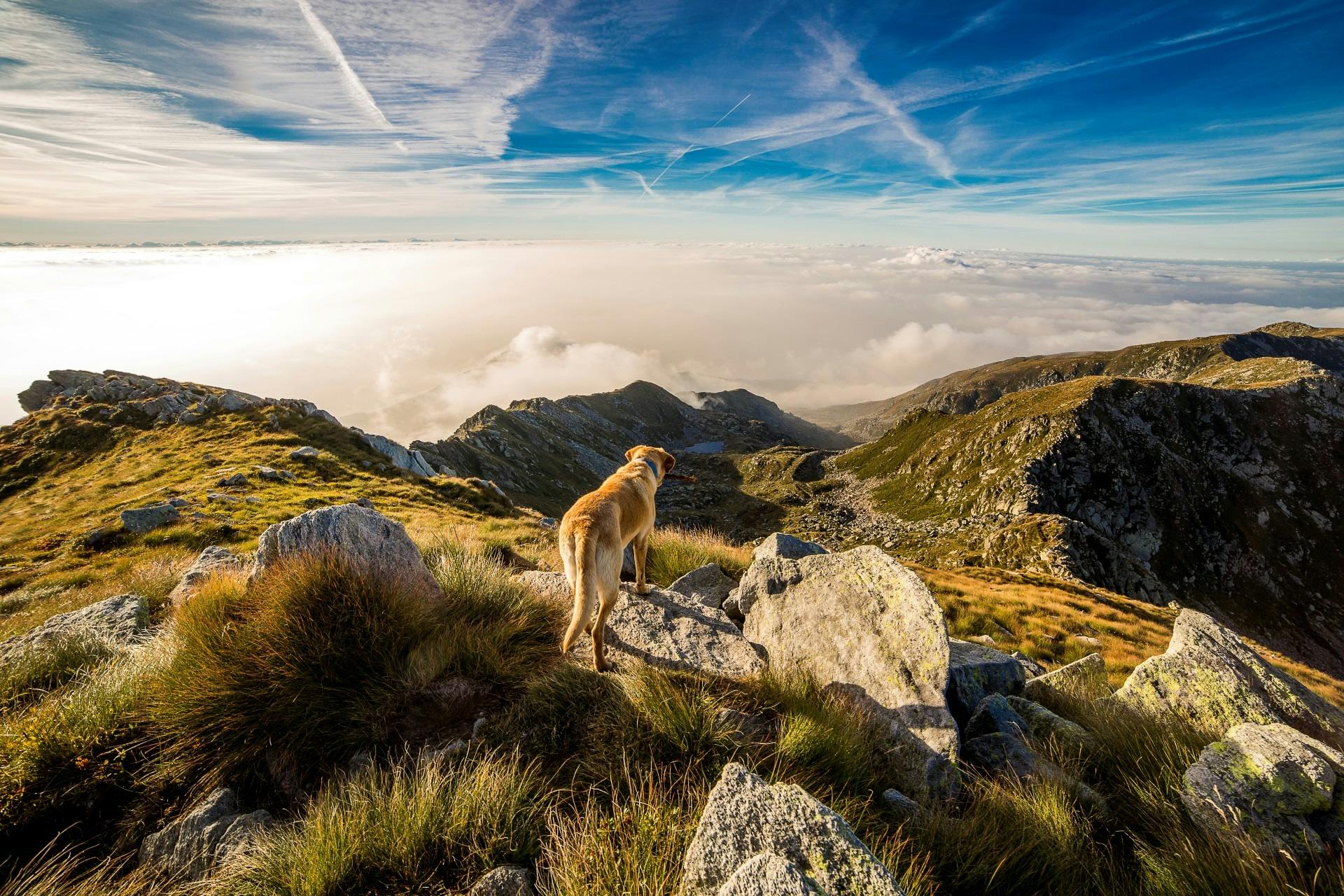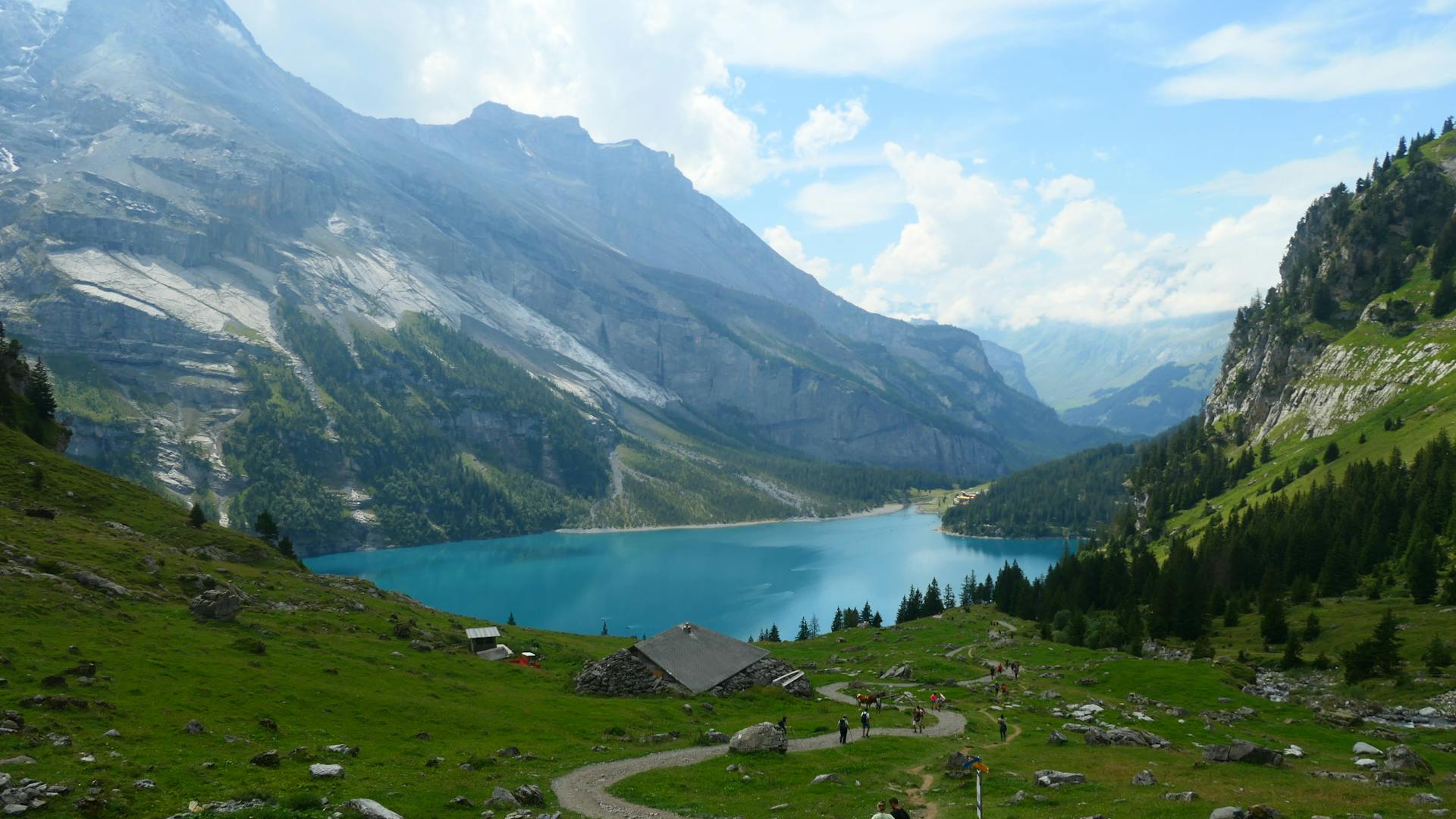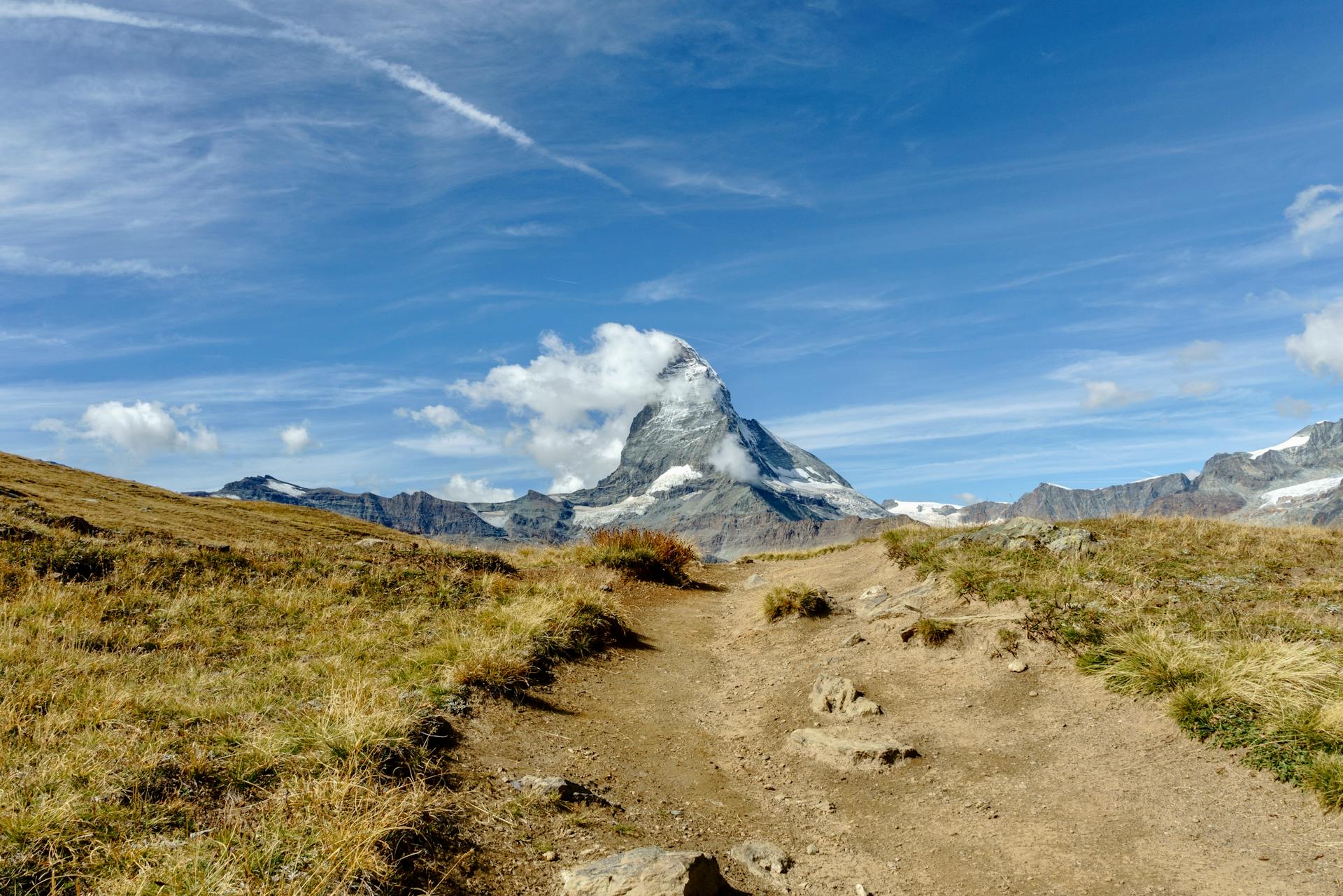
The Greater Swiss Mountain Dog is a breed that's steeped in history and tradition. They originated in Switzerland as a working dog, specifically designed to pull carts and drive cattle.
These dogs are known for their intelligence and trainability, making them a popular choice for families and working roles. They're also highly energetic and require regular exercise to stay happy and healthy.
Their distinctive tri-colored coat is a result of their original purpose as a working dog, where a visible coat was beneficial for identification. This coat pattern is a defining characteristic of the breed.
The Greater Swiss Mountain Dog is generally a healthy breed, but like all breeds, they can be prone to certain health issues, such as hip dysplasia and elbow dysplasia.
Explore further: Pictures of Greater Swiss Mountain Dogs
A Majestic Legacy
The Greater Swiss Mountain Dog is an ancient breed that's been around for approximately 2,000 years, with evidence suggesting their lineage began over two millennia ago.
They originated in the Swiss Alps, where Roman Legions brought their mastiffs to cross with local working dogs, resulting in the four Sennenhund breeds, including the Greater Swiss Mountain Dog, Appenzeller, Entlebucher, and Bernese Mountain Dog.
The Greater Swiss Mountain Dog is known for its robust size and strength, making it the largest among its brethren.
Their distinctive tricolor coat of black, white, and rust, complemented by expressive brown eyes, is a hallmark of the breed.
These dogs were originally bred to be multipurpose farm dogs, herding cattle, pulling carts, and serving as watchdogs, earning them the nickname "the poor man's horse."
In the late 1800s, automation and mechanization led to a decline in the breed's population, but thanks to the efforts of breed aficionados, including Dr. Albert Heim, the Greater Swiss Mountain Dog was recognized by the Swiss Kennel Club in 1910 and later by the American Kennel Club (AKC) in 1995.
Today, the Greater Swiss Mountain Dog is a beloved companion, cherished for its gentle temperament, intelligence, and affectionate nature.
Here are some key characteristics of the Greater Swiss Mountain Dog:
- Size and Strength: Distinguished as the most sizable among the Swiss working dog breeds.
- Gentle Temperament: Esteemed for their genial nature, despite their formidable appearance.
- Exquisite Coat: A hallmark tricolor pattern that stands as a testament to the breed's distinct lineage.
- Family-Oriented: Making for excellent household pets due to their tenderness towards family members.
- Heritage and Service: A breed that encapsulates their legacy of herding and guarding with resilience and nobility.
The Greater Swiss Mountain Dog's majestic legacy continues to captivate those who value the profound bonds forged between dogs and humanity across the ages.
Breed Appearance
The Greater Swiss Mountain Dog's appearance is a testament to its rugged and versatile heritage. Their short, dense coat is a defining feature, and it comes in three standard color combinations: black, white, and red; red and white; and blue, white, and tan.
Their ears are medium-sized and triangular, set high on their heads and lying close to the skull when at rest. But when alert, their ears are raised and sit further forward, giving them a keen and attentive look.
The Greater Swiss Mountain Dog's eyes are a standout feature, with a medium size and almond shape. They're usually dark brown in color, although medium brown is also desirable, and are animated yet gentle in expression.
Their muzzle is strong and straight, with a blunt shape and black lips. The flews are only slightly developed, giving them a clean and well-defined appearance.
For another approach, see: When Should I Breed My Female Dog
Muzzle
The muzzle of the Greater Swiss Mountain Dog is a distinctive feature, and it's worth taking a closer look. It's strong and straight, with a blunt shape that's never pointed or snipey.
One of the key characteristics of the muzzle is its black lips, which are clean and dry, much like a dry-mouthed breed. The flews are only slightly developed, adding to the overall shape and structure of the muzzle.
The muzzle is about the same length as the back skull, giving the dog a balanced and proportionate appearance. This is just one of the many features that contribute to the breed's sturdy and muscular build.
The Neck
The neck is a defining feature of this breed, and it's essential to get it right. The strong, muscular, rather thick neck is of moderate length.
A well-proportioned neck is crucial for this breed's overall appearance. There should be no dewlap.
Forequarters
The forequarters of this breed are quite impressive. The shoulder blades are long and well laid back, forming a moderate angle with the upper arm. They are well muscled and fit closely to the body. This muscular build gives the breed a strong and athletic appearance.
Body

The Greater Swiss Mountain Dog's body is a testament to its sturdy and muscular build. Its proportion of body length to height is 10 to 9, giving it a compact and balanced appearance.
The chest is deep and broad, and the ribs are well sprung, allowing for a strong and efficient breathing system. This is essential for a working dog like the Swissy, which needs to be able to perform physically demanding tasks.
The back is fairly long, strong and straight, providing a solid foundation for the dog's overall structure. The loin is broad and well muscled, while the croup is long, broad and slightly sloping, giving the dog its characteristic shape.
There is very little tuck up, which means that the dog's body is relatively straight and level, with no significant narrowing of the waist. This is a desirable trait in a breed that is meant to be sturdy and powerful.
Here are the key body measurements for the Greater Swiss Mountain Dog:
- Body length to height ratio: 10 to 9
- Chest: deep and broad
- Ribs: well sprung
- Back: fairly long, strong and straight
- Loin: broad and well muscled
- Croup: long, broad and slightly sloping
Breed Characteristics
The Greater Swiss Mountain Dog is a unique breed, and one of its most striking characteristics is its confident and fearless nature. They're self-assured and watchful, making them excellent watchdogs.
Their temperament is also marked by a strong herding instinct, which can sometimes lead to chasing cars and small animals. This is a trait that's been passed down through centuries of breeding, and it's essential to be aware of it when considering this breed.
In terms of their family dynamics, Greater Swiss Mountain Dogs are devoted and agreeable companions, getting along well with children and strangers alike. They thrive on attention and can become dependent on their family, so regular interaction is crucial.
Here are some key characteristics of the Greater Swiss Mountain Dog breed:
- Confident and fearless
- Self-assured and watchful
- Strong herding instinct
- Devoted and agreeable companion
- Good with children and strangers
Head
The head of a Greater Swiss Mountain Dog is strong in proportion to the body, but not heavy.
Males have more distinct head development than females.
The skull of these dogs is flat and broad, with a slight stop.
Related reading: Bull Terrier Head Shape
Ears

The ears of this breed are quite distinctive, and one of the first things you'll notice is their triangular shape.
They're medium in size, gently rounded at the tip, and set fairly high on the head.
The top of the ear is level with the top of the skull, giving the dog a unique appearance.
When the dog is at rest, the ears hang close to the head, but when it's at attention, they're raised at the base and carried forward.
Readers also liked: When to Spay Bernese Mountain Dog
Tail
The tail is a crucial part of a dog's anatomy, and its characteristics can vary greatly between breeds. It's set on the natural line of the croup, which is the curvature of the dog's back just above the tail.
A well-proportioned tail is fairly heavy and reaches to the hock in length, which is the joint below the knee. The tail is pendulous when the dog is in repose, meaning it hangs down naturally.
When the dog is alert or moving, its tail is carried higher and with a slight curve, but never curled or raised over the back. This shows the dog is engaged and ready to respond.
See what others are reading: Straight Back German Shepherds
Breed Standard Characteristics
The Greater Swiss Mountain Dog is a sturdy and muscular breed with a flat and broad skull that has a slight stop. Their muzzle is about the same length as the back skull.
Their outer coat is about one or two inches thick and very dense, with a thick undercoat. The fur is short and tri-colored, with a black base and rust markings on the chest and cheeks as well as over the eyes, and white colored markings on the chest, muzzle and possibly on the neck.
These dogs have a level topline, compact, round feet, and a broad chest. Their tail is thicker at the base than at the tip where it ends in a point, and it will reach down to the hocks.
The Greater Swiss Mountain Dog is a harmonious blend of power and agility, a legacy of its working past. They are self-confident, watchful, and fearless, with an agreeable and devoted nature towards their family.
A different take: Greater Swiss Mountain Dog Bernese Mountain Dog Mix
Their eyes vary from chestnut to hazel, but are always almond-shaped and medium in size. Their ears are medium in size, triangularly shaped with slightly rounded tips, and lie close to the head.
The Greater Swiss Mountain Dog has a solid and sturdy build, reflecting its functionality through every aspect of its physique. They personify the balance between power and grace, making them a beautiful and impressive breed to behold.
Breed Maintenance
To ensure your Greater Swiss Mountain Dog lives a happy and healthy life, it's essential to provide them with the right environment. They thrive in large, fenced-in yards where they can roam freely, and they love playing in the snow, but they can be prone to heat stroke in hot weather.
When exercising your Swissy, make sure they always have access to water and shade, and limit their exercise to early mornings and evenings when it's not as hot. You should also be mindful of their joint growth, as they can be prone to jumping and running on hard surfaces until they're about two years old.
Here's a summary of their exercise needs:
- Daily walks to keep them active and cater to their endurance.
- Weight-pulling activities to harness their natural strength and working instincts.
- Agility training to benefit their coordination and keep their minds sharp.
- Regular play sessions to promote bonding and provide physical exercise.
In terms of feeding, you should aim for a balanced diet rich in nutrients, with meals that are rich in proteins to support their muscular health. Be mindful of the amount to prevent overfeeding and potential obesity, which can exacerbate joint issues.
Grooming Essentials for Short Coats
Grooming the Swissy is a relatively straightforward affair thanks to their short, "wash-and-wear" coat.
Regular brushing is pivotal, especially during shedding seasons, to remove dead hair and maintain coat health. You can use a firm-bristled brush weekly to keep their coat shiny and reduce shedding.
Bathing is not necessary too often, as their coat does not require frequent washing. In fact, you should only bathe your Swissy when necessary.
Trimming their nails regularly is crucial to avoid overgrowth, which can cause discomfort or even injury. You can trim their nails once a month, or less often if they get worn down naturally.
To keep their coat healthy and shiny, brush their teeth daily to avoid gum disease and plaque buildup. An annual dental deep clean by your vet is also recommended.
Here's a quick rundown of grooming essentials for your Swissy:
- Firm-bristled brush for weekly brushing
- Bathing as needed (not too often)
- Nail trimming once a month
- Daily tooth brushing
By following these simple grooming tips, you'll ensure your Swissy not only looks great but also feels comfortable and stays healthy.
Nutrition and Feeding Tips
To ensure your Swissy stays healthy and happy, it's essential to feed them a balanced diet that meets their nutritional needs. This means focusing on meals rich in proteins to support their muscular health.
A good starting point is to opt for formulas tailored for large breeds with the right nutrient ratios. This will help your Swissy get the essential dietary requirements necessary for overall health.
Be mindful of the amount you feed your Swissy to prevent overfeeding and potential obesity, which can exacerbate joint issues. This is especially important for large breeds like the Swissy.
Here's an interesting read: English Mastiff Large
To decrease the risk of bloat, a serious health concern in large dogs, space out your Swissy's meals throughout the day. This will also help prevent overeating and ensure they're getting the nutrients they need.
Engage with your veterinarian to tailor a feeding schedule and portion size that corresponds to your Swissy's individual health profile and energy needs. This will help foster optimal health and ensure your Swissy stays happy and healthy.
Here are some key guidelines to keep in mind:
- Feed meals rich in proteins to support muscular health.
- Opt for formulas tailored for large breeds with appropriate nutrient ratios.
- Be mindful of the amount to prevent overfeeding and potential obesity.
- Space out meals throughout the day to decrease the risk of bloat.
The Gentle Giant's Temperament
Greater Swiss Mountain Dogs are known for their calm and good-natured spirit, making them exceptional candidates for inclusion in family environments. They embody a perfect blend of strength and sweetness.
They are celebrated as one of the top affectionate dog breeds, ideal for those looking to enrich their family with a canine companion. Their patient and understanding nature creates a nurturing space for growth and learning.
These dogs are innately affectionate towards children and transition seamlessly into family life, showcasing the ideal qualities of family dog breeds. They are a comfort in homes with younger members.
You might enjoy: All about Pitbull Dog
Their protective instincts are evident in their notable bark, which serves as an alert system. Yet, they exhibit a warm reception to friendly guests, proudly displaying the inclusive traits that make Greater Swiss Mountain Dogs a beloved choice.
Here are some key characteristics of the Gentle Giant's temperament:
- Protective yet welcoming to friends and family
- Exhibits warmth and gentle playfulness
- Mellow and patient with children of all ages
Their temperament transcends mere companionship to encompass a true devotion to their human counterparts, embodying the very essence of a family-oriented canine.
Health and Wellness
Greater Swiss Mountain Dogs are prone to certain health issues that can affect their bones, joints, and overall well-being. Regular veterinary check-ups and monitoring can help identify potential problems early on.
Hip dysplasia is a common concern in GSMDs, causing arthritis and lameness. Elbow dysplasia can also cause joint discomfort and reduced mobility. Eye conditions like distichiasis can irritate the eyes and cause excessive tearing.
To prevent these issues, it's essential to maintain your GSMD's weight through regular exercise and a balanced diet. Feeding a large-breed puppy diet and avoiding overfeeding can help prevent growth-related problems like osteochondritis dissecans (OCD). Regular eye checks can also help detect distichiasis.
Check this out: Hip Dysplasia Bernese Mountain Dog
Here's a summary of common health concerns in GSMDs:
Bloat
Bloat is a serious health concern for Greater Swiss Mountain Dogs. The breed is more prone to Gastric Dilatation and Volvulus, also known as GDV or Bloat, due to its deep and narrow chest.
This condition can be fatal if left untreated, sometimes in as little as 30 minutes. Bloat occurs when the stomach twists on itself and fills with gas, cutting off blood supply to the stomach and sometimes the spleen.
Your GSMD may exhibit symptoms such as retching or heaving, acting restless, having an enlarged abdomen, or lying in a prayer position with front feet down and rear end up. If you notice any of these symptoms, take your pet to an emergency hospital immediately.
Preventive surgery is an option to tack down or suture the stomach in place, making it less likely to twist. This surgery can help prevent Bloat in your GSMD.
Wellness: Common Concerns

Greater Swiss Mountain Dogs are prone to various health concerns that can be managed with proper care and attention. Hip dysplasia is a common issue in this breed, where the hip joint fails to develop correctly, leading to arthritis or lameness.
Regular exercise and weight management can help prevent or alleviate hip dysplasia. Orthopedic screenings are also essential to detect any issues early on. I've seen many dogs benefit from regular exercise and a healthy diet, and it's amazing how much it can improve their quality of life.
Elbow dysplasia is another condition that can cause joint discomfort and reduced mobility in GSMDs. Proper nutrition, joint supplements, and veterinary evaluations can help prevent or manage this condition.
GSMDs are also susceptible to eye conditions like distichiasis, which involves an abnormal growth of eyelashes causing irritation. Regular eye checks are crucial to detect this condition early on, and in some cases, surgical corrections may be necessary.
A fresh viewpoint: Bernese Mountain Dog Exercise

Gastric dilatation-volvulus (GDV) is a life-threatening emergency that requires rapid treatment. Avoiding exercise after feeding and feeding smaller, more frequent meals can help prevent GDV.
Here's a summary of the common health concerns in GSMDs:
By being aware of these common health concerns and taking proactive steps to prevent or manage them, you can help your GSMD live a long, happy, and healthy life.
Care and Lifestyle
Caring for a Greater Swiss Mountain Dog is a big responsibility, but with the right approach, it can be a breeze. They need regular exercise to stay happy and healthy, so plan to take them out for a run or playtime every day.
To keep your Swissy's diet on track, feed them a high-quality food that's suitable for their age, and avoid giving them people food. This will help prevent digestive issues and keep their energy levels stable.
Brushing their coat is a must, but don't worry, it's not a daily task. Aim for at least weekly brushing to prevent matting and tangling. Their teeth also need regular attention, so brush them at least twice a week to keep them clean and healthy.
Here's a quick rundown of their grooming needs:
- Brush their coat at least weekly
- Brush their teeth at least twice a week
- Clean their ears weekly
Keep an eye on their temperature, as they can be sensitive to warm temperatures. Make sure to provide plenty of shade and water to prevent heat stress. By following these simple tips, you'll be well on your way to becoming a great Greater Swiss Mountain Dog owner.
Frequently Asked Questions
Why are Greater Swiss Mountain Dogs so rare?
Greater Swiss Mountain Dogs are relatively rare due to the decline in demand for draft dogs with the rise of mechanized transport. This shift in transportation methods led to a decrease in the traditional use of Swissy as draft dogs.
What's the difference between a Greater Swiss Mountain Dog and a Bernese Mountain Dog?
Greater Swiss Mountain Dogs are generally larger and have a shorter coat than Bernese Mountain Dogs, which have longer fur. This difference in size and coat length sets them apart from one another.
Will a Greater Swiss Mountain Dog protect you?
Yes, Greater Swiss Mountain Dogs are excellent guard dogs, but they require proper training and supervision to ensure they effectively protect their family. With the right care and attention, they can be loyal and vigilant companions.
What are the four breeds of Swiss Mountain Dogs?
The four breeds of Swiss Mountain Dogs are the Greater Swiss Mountain Dog, Bernese Mountain Dog, Appenzeller Mountain Dog, and Entlebucher Mountain Dog. These four breeds are part of the Sennenhund family, originating from Switzerland.
Do Swissies bark a lot?
Yes, Greater Swiss Mountain Dogs are known for their resounding bark, which they use to alert their owners to potential issues. Their barking is a natural part of their friendly and alert temperament.
Sources
- https://wagwalking.com/breed/greater-swiss-mountain-dog
- https://midwayanimal.com/client-resources/breed-info/greater-swiss-mountain-dog/
- https://be.chewy.com/dog-breed/greater-swiss-mountain-dog/
- https://www.articlesfactory.com/articles/animals-and-pets/greater-swiss-mountain-dog.html
- https://www.ukcdogs.com/greater-swiss-mountain-dog
Featured Images: pexels.com


